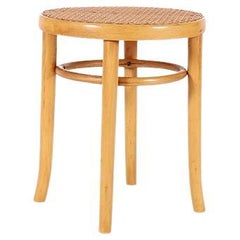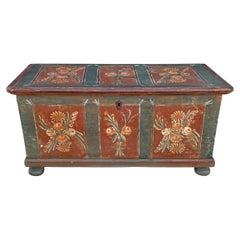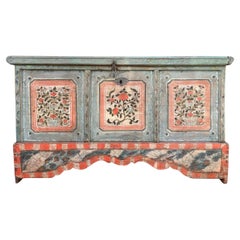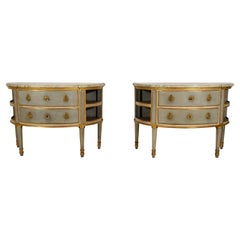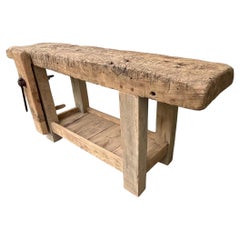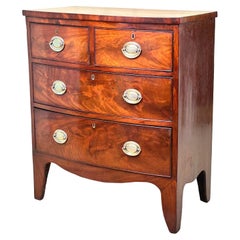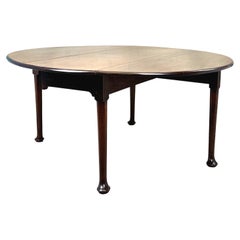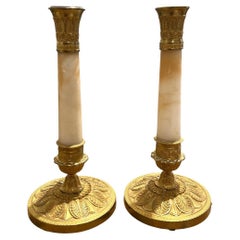Antique Furniture Restoration
Early 20th Century Polish Bohemian Antique Furniture Restoration
Cane, Beech
1850s Italian Other Antique Furniture Restoration
Fir
1810s Austrian Louis XVI Antique Furniture Restoration
Fir
1820s Italian Neoclassical Revival Antique Furniture Restoration
Fir
Late 18th Century Italian Neoclassical Antique Furniture Restoration
Marble, Bronze
Early 20th Century French Arts and Crafts Antique Furniture Restoration
Oak
Mid-19th Century English Victorian Antique Furniture Restoration
Mahogany
Mid-18th Century English Georgian Antique Furniture Restoration
Mahogany
19th Century French Antique Furniture Restoration
Alabaster, Bronze
Early 19th Century French Restauration Antique Furniture Restoration
Mahogany
19th Century French Restauration Antique Furniture Restoration
Leather, Fruitwood
1820s French Antique Furniture Restoration
Bronze
1910s French Restauration Antique Furniture Restoration
Upholstery, Cherry
19th Century Antique Furniture Restoration
Marble
19th Century French Restauration Antique Furniture Restoration
Mahogany, Upholstery
19th Century Rustic Antique Furniture Restoration
Wood
19th Century Rustic Antique Furniture Restoration
Pine
19th Century Federal Antique Furniture Restoration
Brass
1820s French Restauration Antique Furniture Restoration
Upholstery, Mahogany
19th Century Georgian Antique Furniture Restoration
Wood
19th Century French Restauration Antique Furniture Restoration
Bronze
19th Century French Restauration Antique Furniture Restoration
Marble
1830s French Antique Furniture Restoration
Porcelain
1820s French Neoclassical Antique Furniture Restoration
Abalone, Silk, Upholstery, Foam, Mahogany
1840s Neoclassical Antique Furniture Restoration
Brass
1830s French Charles X Antique Furniture Restoration
Bronze
19th Century French Louis XV Antique Furniture Restoration
Mirror, Giltwood
19th Century English Campaign Antique Furniture Restoration
Brass
Late 19th Century Unknown Georgian Antique Furniture Restoration
Leather, Wood
Early 19th Century Georgian Antique Furniture Restoration
Mercury Glass, Giltwood
Late 19th Century Louis XV Antique Furniture Restoration
Fabric, Walnut
Late 19th Century Napoleon III Antique Furniture Restoration
Felt, Wood
1820s French Restauration Antique Furniture Restoration
Mirror, Giltwood
19th Century English George III Antique Furniture Restoration
Brass
1830s French Restauration Antique Furniture Restoration
Wood, Glass
1830s French Restauration Antique Furniture Restoration
Mirror, Giltwood, Stucco
1840s French Empire Revival Antique Furniture Restoration
Stone, Bronze
1840s French Restauration Antique Furniture Restoration
Yew, Fruitwood
1820s French Restauration Antique Furniture Restoration
Mirror, Giltwood
19th Century Neoclassical Antique Furniture Restoration
Marble, Brass
19th Century French Neoclassical Antique Furniture Restoration
Bronze, Ormolu
19th Century English Georgian Antique Furniture Restoration
Hardwood
19th Century French Antique Furniture Restoration
Griotte Marble, Bronze
19th Century French Georgian Antique Furniture Restoration
Mirror, Giltwood
19th Century Rococo Antique Furniture Restoration
Marble
1820s French Restauration Antique Furniture Restoration
Bronze
19th Century Rustic Antique Furniture Restoration
Oak
19th Century Unknown Antique Furniture Restoration
Fabric, Wood, Trimming
19th Century French Charles X Antique Furniture Restoration
Mahogany, Maple
18th Century Georgian Antique Furniture Restoration
Wood
19th Century English William IV Antique Furniture Restoration
Walnut
19th Century Antique Furniture Restoration
Mahogany
Early 20th Century Hollywood Regency Antique Furniture Restoration
Mirror, Wood
1890s French Restauration Antique Furniture Restoration
Silver Leaf
19th Century Federal Antique Furniture Restoration
Mirror, Wood
19th Century Adam Style Antique Furniture Restoration
Wood
Late 19th Century English Antique Furniture Restoration
Oak
1840s French Restauration Antique Furniture Restoration
Yew, Fruitwood
1860s English Aesthetic Movement Antique Furniture Restoration
Leather, Hardwood
Early 19th Century French Restauration Antique Furniture Restoration
Bronze
- 1
Antique Furniture Restoration For Sale on 1stDibs
How Much is a Antique Furniture Restoration?
- 1stDibs ExpertApril 5, 2022Yes, bamboo furniture can indeed be restored. Repair any mildly broken pieces with some heavy duty wood glue. The exterior can also be refinished by sanding off dirt and grime and repainting the piece. You’ll find a large collection of bamboo items from many of the world’s top sellers on 1stDibs.
- 1stDibs ExpertApril 22, 2024Where Restoration Hardware furniture is made depends on the piece. Most of the luxury brand's furniture comes from factories in China. However, the company does manufacture some furnishings in the U.S. and other countries, such as Australia, Indonesia and India. On 1stDibs, find a selection of Restoration Hardware furniture.
- 1stDibs ExpertOctober 19, 2021The best furniture polish is really a matter of preference. A restoring oil like Pledge Restore & Shine is recommended for a luxurious gloss, especially on unfinished wood. If wood furniture is not polished, it will lose its luster over time. Find a collection of antique and vintage polished furniture on 1stDibs today.
- 1stDibs ExpertJune 30, 2023To restore oxidized aluminum patio furniture, you can apply a furniture polishing paste labeled as safe for aluminum. Follow the usage instructions printed on the packaging for the best results. A solution of warm water and vinegar may also help remove oxidation. On 1stDibs, find a variety of patio furniture.
- 1stDibs ExpertApril 5, 2022Yes, Restoration Hardware furniture is primarily manufactured in China. Now known as RH, the company prides itself as a curator of high-quality design and style with various home furniture and decor offerings. You’ll find a large variety of RH furniture on 1stDibs.
- 1stDibs ExpertMay 30, 2024To identify your antique furniture, look for an engraving, tag, label or other marking that indicates who produced it. You may find it on the bottom or back of your furniture or inside a drawer or cabinet. Once you have located the marking, you can snap a photo of it and use a reverse image search to try and identify the maker. Or, you can type a description of the mark into a search engine. Alternatively, you can use the services of a certified appraiser or antiques dealer to get assistance with identification. On 1stDibs, shop a large selection of antique furniture.
- What makes furniture an antique?1 Answer1stDibs ExpertAugust 15, 2019
A piece of furniture is considered an antique if it is at least 100 years old.
- Is antique furniture in style?1 Answer1stDibs ExpertApril 22, 2024Yes, antique furniture is in style. Many people appreciate the beauty and handcrafted character of antique furniture and love the idea of owning pieces with a rich history. Remember that style preferences are nothing if not fluid, meaning what's in one year may not be the next. So, in choosing the furniture you're planning to live with, you should pay less attention to interior design fads than to what speaks to you. That way, you can select pieces that will add long-term character to your home. On 1stDibs, find a large collection of antique furniture.
- 1stDibs ExpertApril 5, 2024To know if your furniture is antique, look for labels and markings that indicate the maker. From there, you can use trusted online resources to determine when they were active and examine images to try to estimate the age of your piece. Furniture produced 100 years ago or more is antique. You can also have your furniture assessed by an appraiser or antiques dealer to learn about its age. On 1stDibs, explore a large collection of antique furniture.
- 1stDibs ExpertMay 14, 2024Many antique furniture brands are popular. While trends in collecting do vary over time, some makers consistently remain highly sought after. Among them are J. & J.W. Meeks, John Henry Belter, R. J. Horner and Co., Stickley Furniture, George Hepplewhite, Josef Dannhauser, Thomas Chippendale and Thomas Sheridan. On 1stDibs, shop a variety of antique furniture.
- 1stDibs ExpertFebruary 22, 2021There are a number of factors that can indicate if your antique furniture is valuable. When determining the value of antique furniture, consider its rarity. Additionally, it is important to determine the quality and condition of vintage furniture. If unsure of the value of your vintage furniture, have it appraised.
- 1stDibs ExpertFebruary 22, 2021Antique furniture can be worth quite a lot, particularly if it is in good quality. The rarer the piece, the higher the value.
- 1stDibs ExpertFebruary 13, 2024Whether antique furniture is making a comeback is a matter of opinion. Many people would argue that antique furniture never faded from fashion, as there have always been individuals who love the idea of owning pieces that have history. Some of the most popular styles for antique furniture include Art Deco, Arts and Crafts, Renaissance Revival, Elizabethan, Gothic Revival, Victorian and Chippendale. Find a large collection of antique furniture from some of the world's top dealers on 1stDibs.
- 1stDibs ExpertFebruary 1, 2024To date antique furniture from the UK, first look for identifying markings on the piece. You can then use trusted online resources to determine when the maker was active. From there, you may be able to estimate the year of production by looking at images of other furniture the maker produced. An expert appraiser or antiques dealer can also aid you in the dating process. Find a large selection of antique furniture on 1stDibs.
- 1stDibs ExpertNovember 13, 2024How old furniture that is called antique can be is typically at least 100 years. People usually call furniture between 20 and 99 years old vintage. Contemporary is the word for furniture manufactured within the last 20 years. On 1stDibs, shop a large selection of antique, vintage and contemporary furniture from some of the world's top sellers.
- 1stDibs ExpertOctober 5, 2021The best finish for antique furniture is a matter of liking. But film finish is recommended by experts as it leaves a thick coat of film on the wood surface which protects wood from water and scratches. Shellac or varnish and water base are commonly used film finishes. Find an exquisite collection of antique, new and vintage furniture on 1stDibs
 PAGODA REDOctober 7, 2020
PAGODA REDOctober 7, 2020To determine the age of a Chinese furniture piece, look carefully at the joinery and finish. Natural expansion and contraction of the wood over time will cause a joint to protrude or retract, distorting a once-seamless fit. Antique lacquer finishes become crackled and worn over time. Areas of exposed wood, such as the underside of a table, the footrest of a chair, or the back of a cabinet should appear raw and dry compared to the finished surface. With use, the legs of tables and chairs become weathered near the bottom from precipitation and use.
- 1stDibs ExpertAugust 29, 2024To tell how old your antique furniture is, research the maker using trusted online resources. You may find that the furniture maker was active for only a short period, giving you the ability to roughly estimate its age. For manufacturers and designers with a long history of production, consider the style of your furniture and look for images of similar pieces published online. Because it may be difficult to date furniture on your own, consider consulting a certified appraiser or knowledgeable antique dealer. On 1stDibs, explore a variety of antique furniture.
- 1stDibs ExpertAugust 20, 2024To tell what your antique furniture is worth, look at sales histories on trusted online platforms and read valuation guides posted on trusted online resources. The maker, type, style, age and condition of your furniture will impact its value. Researching furniture produced by the same maker is a good starting point. A certified appraiser or knowledgeable antique dealer can also aid you in the valuation process. Find a large collection of antique furniture on 1stDibs.
- 1stDibs ExpertNovember 4, 2024To identify antique Chinese furniture, look carefully at its details. Chinese craftsmen often built furniture using mortise and tenon joinery, eliminating the need for nails and screws. If you see this type of hardware, your piece is likely not at least 100 years old, especially if the hardware still looks new and shiny. Since antique furniture was handmade, you will normally see slight imperfections, such as tool marks or slight variations in carvings. Pieces that appear completely uniform and pristine are less often genuine antiques.
When present, maker's marks can also be helpful. Research the marks to learn more about when the maker was active and producing pieces like yours. Alternatively, you can have a certified appraiser or experienced antique dealer evaluate your furniture for you.
Shop an assortment of antique Chinese furniture.
